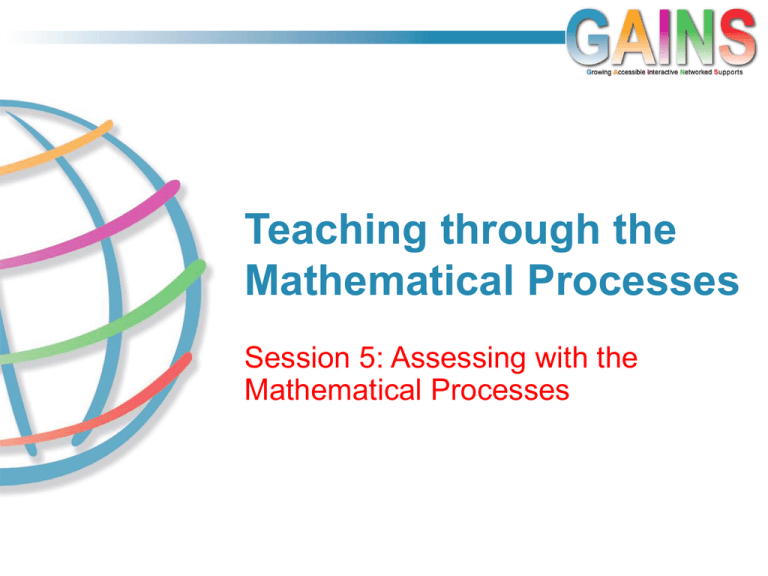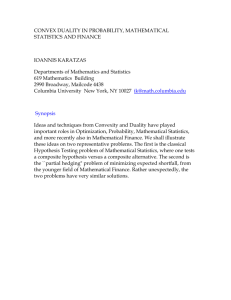
Teaching through the
Mathematical Processes
Session 5: Assessing with the
Mathematical Processes
Retention Timeline
0
2
4
6
years
Pink: time students retain knowledge
through procedures
Yellow: time students retain knowledge
through concepts
Blue: time students retain knowledge
through mathematical processes
8
10
What are we teaching?
• Reflect on the relevance of the video to
retention and life-long learning.
• Share your ideas with a partner.
Assessing the Processes
Assessment - Evaluation - Reporting
What is Classroom Assessment?
One possible answer:
Classroom Assessment refers to the collection of
information teachers use to monitor students’
learning, provide feedback and to make appropriate
adjustments to instruction.
Exploring Classroom Assessment in Math NCTM 1998
Name That Process…
• Identify the Mathematical Process that
can be assessed for the given criteria.
• Share your choice with a partner.
Mathematics Processes Rubric
Think
→Tools
Pair
→
ShareStrategies
Selecting
Reasoning
Problem
Communicating
and
Representing
Connecting
Reflecting
Computational
and
Solving
Proving
Criteria
Criteria
Criteria
Criteria
Criteria
Criteria
Criteria
Creates
a model
to
represent
the
problem
Uses
clear
language
to make
presentations,
and to explain
Formulates
and
defends
a
hypothesis
or
conjecture
Makes
connections
among
mathematical
concepts
and
Selects,
sequences
and
applies
mathematical
processes
Uses
metacognitive
skills
to
determine
which
mathematical
(e.g.,
numerical,
algebraic,
graphical,
physical,
or
scale
and
justify
solutions
when
reporting
for
various
purposes
procedures
appropriate
touses
the
processes
to
revisit
in order
to reach the
model,
by
hand
or task
using
technology)
Selects
and
tools
and
strategies
to goal
solve
problem
and
different
audiences
Makes
inferences,
draws
conclusions
and
givesajustifications
Relates
mathematical
ideastotosolve
situations
drawn from other
Uses
critical
thinking
skills
a
problem
Reflects
on
the
reasonableness
of
answers
Makes
connections
between
numeric,
graphical
and
Uses mathematical symbols, labels, units and conventions
contexts
Interpretsrepresentations
mathematical language, charts, and graphs
algebraic
correctly
Uses mathematical
appropriately
Translates
from onevocabulary
representation
to another as appropriate
to the problem
Generic Processes Rubric
BLM5.1
Thinking
Problem Solving
Criteria
Below Level 1
Level 1
Level 2
Level 3
Level 4
Specific Feedback
Selects, sequences
and applies
mathematical
processes appropriate
to the task
Selects, sequences and
applies mathematical
processes to the assigned
task with significant
prompting
Selects, sequences and
applies mathematical
processes to the assigned
task with minimal prompting
Selects, sequences and
applies mathematical
processes to the assigned
task independently
Selects, sequences and
applies mathematical
processes to the assigned
task independently with a
broader view of the task
Uses critical thinking
skills to solve a
problem
Uses minimal logic and
precision in mathematical
reasoning to solve problems
Uses logic to solve
problems but lacks
precision in mathematical
reasoning
Solves problems logically
and with precision in
mathematical reasoning
Demonstrates a
sophisticated level of
mathematical reasoning and
precision in solving
problems
Reasoning and Proving
Criteria
Below Level 1
Specific Feedback
Level 1
Level 2
Level 3
Level 4
Formulates and
defends a hypothesis
or conjecture
Forms a hypothesis or
conjecture that connects
few aspects of the problem
Forms a hypothesis or
conjecture that connects
some of the pertinent
aspects of the problem
Forms a hypothesis or
conjecture that connects
pertinent aspects of the
problem
Forms a hypothesis or
conjecture that connects
aspects of the problem with
a broader view of the
problem
Makes inferences,
draws conclusions and
gives justifications
Makes limited connections
to the problem-solving
process and models
presented when justifying
answers
Makes some connections to
the problem-solving process
and models presented when
justifying answers
Makes direct connections to
the problem-solving process
and models presented when
justifying answers
Makes direct and insightful
connections to the problemsolving process and models
presented when justifying
answers
Interprets
mathematical
language, charts, and
graphs
Misinterprets a critical
element of the information,
but makes some reasonable
statements
Misinterprets part of the
information, but makes
some reasonable
statements
Interprets the information
correctly and makes
reasonable statements
Interprets the information
correctly, and makes
insightful statements
Opposite Sides
Agree
/
Disagree
/
Don’t Know!
The distance around a tennis ball can
is less than the height of the can.
Justify your answer with your group.
Those who ‘don’t know’ explore further.
= 3 diameters
h = 3 balls
C = diameters
The distance around a tennis ball can is less than the height of the can.
Tennis Ball Can Problem
• What Mathematical Processes
were used in solving the
problem?
• Which criteria could be used
to assess the Mathematical
Processes with this problem?
How do we effectively teach
Mathematical Processes?
• Teach to the curriculum expectations.
• Do investigations and solve rich problems.
• Ask questions and provide feedback related
to the Mathematical Processes.
• Explore the TIPS lessons that demonstrate
how lessons can be adjusted to focus on
particular Mathematical Processes.
Students learn
content and problem solving
by
solving problems
and
sharing solutions
Problem Selection …
Choose one of the following problems to
form working groups.
Volume of Three Dimensional
Shapes
Develop, through
investigation (e.g., using
concrete materials) the
formulas for the volume
of a pyramid, a cone,
and a sphere.
Painted Cube Problem
A 3 x 3 x 3 cube made up of small
cubes is dipped into a bucket of red
paint and removed.
a) How many small cubes will have 3 faces
painted?
b) How many small cubes will have 2 faces
painted?
c) How many small cubes will have 1 face
painted?
d) How many small cubes will have 0 faces
painted?
e) Generalize your results for an
n x n x n cube.
Temperature Problem
The inhabitants of Xenor use two
scales for measuring temperature. On
the A scale, water freezes at 0° and
boils at 80°, whereas on the B scale,
water freezes at -20° and boils at 120°.
What is the equivalent on the A scale of
a temperature of 15° on the B scale?
The Math Forum@Drexel All rights Reserved.
Dart Board Problem
This dart board is designed with
a square inside a circle and a
square outside the same circle.
Assign numerical values of 2, 5,
and 8 to the three coloured
regions on the dart board such
that regions with smaller areas
are assigned higher scores.
Justify your solution.
Minds On: Decking Problem
Deck Problem
You have been
tohired
build
a adeck
attached
Youhired
have been
to build
deck attached
to the to
secondof
flooraofcottage
a cottage using
exactlyexactly
30 m of deck30m
railing.
the second floor
using
(Note:
the entire
outside
edge ofoutside
the deck willedge
have railing.)
of deck railing
(note:
the
entire
will
Determine the dimensions that will maximize the area of
have railing).the deck with the configuration below.
І
http://www.beachside-bb.nf.ca/Accomdations.htm
DECK
=
=
І
Determine the dimensions of
the deck that follow the
specifications in the diagram
and maximize the area of the
deck.
COTTAGE
Combination of Functions Card
Game
Examples
The initial graph of sin(x) and 2x can be combined to
produce the graphs shown below it. Determine what
operations are used to combine them and explain the
reasoning.
sin x and 2x
Problem Selection …
Consider your group problem to answer the
question:
“Which Mathematical Process(es) could be
assessed?”
Assessing the Mathematical
Fishbowl
Processes
Strategy
• Half of the group members “solve” the problem.
• The remaining members observe and assess the
Mathematical Processes, using the given rubric.
• The observing members identify other Mathematical
Processes that become apparent during the problem
solving.
• Discuss the solution strategy and observations.
• Group members switch roles to solve the same or a
different problem.
Debrief
• How did solving this problem provide opportunities
for you to apply Mathematical Processes
• How did the rubric facilitate assessing the
Mathematical Processes specifically?
• What other observations did you make?
Home Activity
Journal Reflection:
What role will the Generic Rubric for
Mathematical Processes play in my
teaching and assessment practices?








